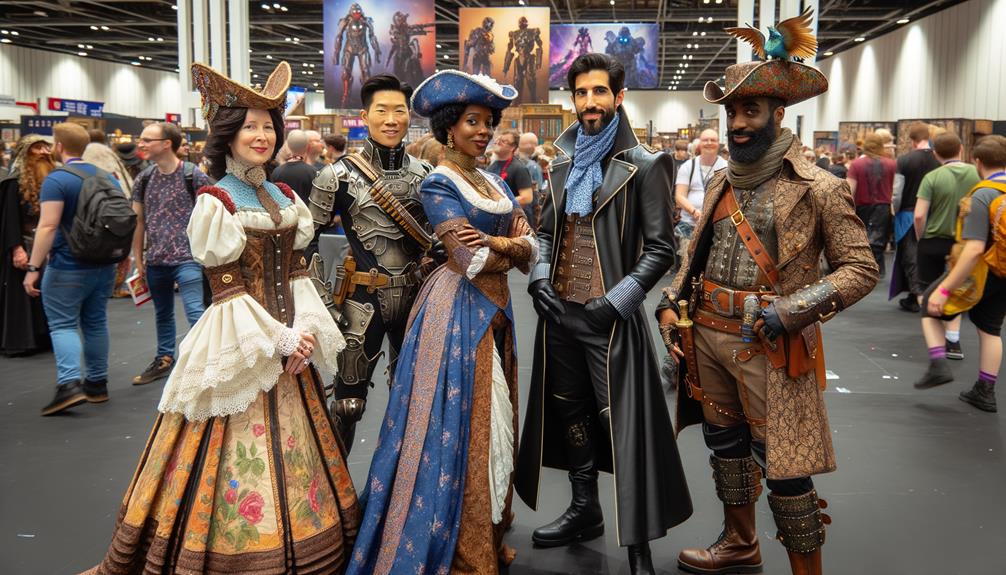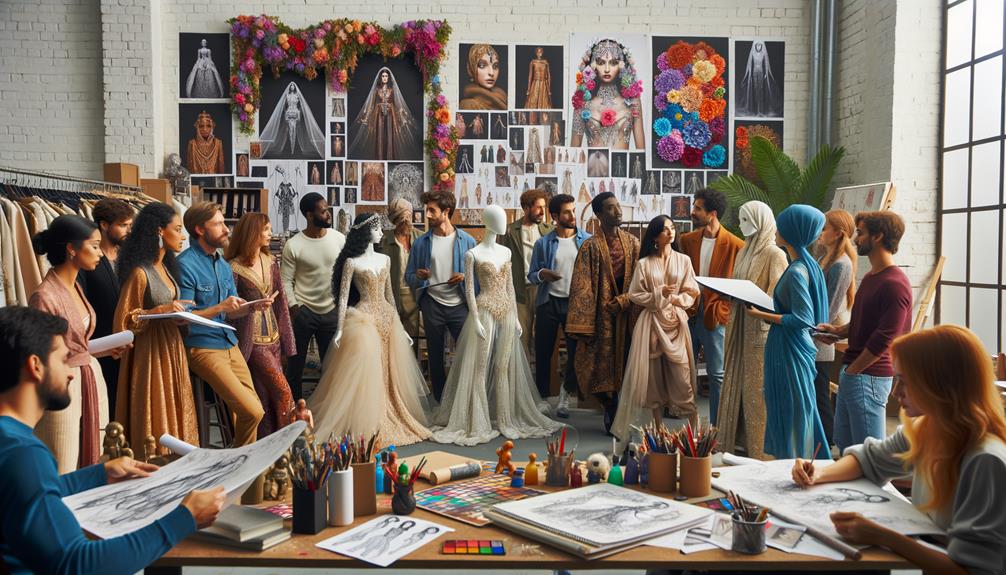Designing outfits for stage and screen is about more than just dressing characters – it’s about bringing their personalities to life through fabric. I carefully select cuts, colors, and textures that reflect their journeys, struggles, and triumphs. To ensure historical accuracy, I pour over ancient texts and museum archives to capture the authentic feel of an era. Working closely with directors, I ensure my vision aligns with the narrative’s core, creating a seamless blend of art and storytelling. I choose fabrics that balance comfort and durability. Each fitting is a crucial step, refining the design to perfection. Let’s dive deeper into this art form.
Understanding Character Development
In the realm of costume design, understanding a character’s development is crucial to creating attire that truly resonates with their journey. Every stitch and fabric choice must mirror the character’s transformation, reflecting their inner turmoil and triumphs. As I delve into the nuances of character development, I realize that clothing serves not just as a visual tool but as a narrative device that speaks volumes about the individual wearing it.
When I design, I immerse myself in the character’s psyche. I ask myself: How does this person’s attire evolve as they grow? What does their clothing say about their past, their aspirations, and their internal conflicts? For instance, a character starting their journey in muted, torn fabrics might find themselves in richly textured, vibrant outfits as they gain confidence and purpose. Each element, from the cut to the color palette, must be meticulously chosen to reflect their growth.
I strive to create outfits that don’t just adorn the character but become an extension of their being. In doing so, I aim to push the boundaries of traditional costume design to craft attire that breathes life into the character’s story.
Researching Historical Accuracy
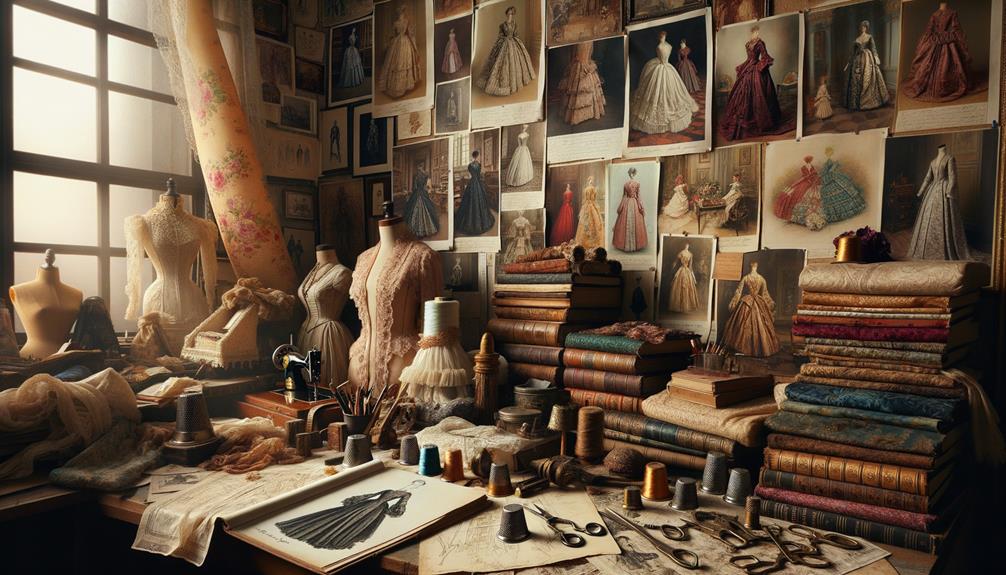
While exploring the world of historical accuracy, I’m drawn to the intricate details that define each era’s unique style. The pursuit of authenticity leads me to uncover the secrets of ancient textiles, forgotten techniques, and period-specific embellishments. It’s not just about recreating garments; it’s about understanding the social and cultural context behind each stitch and seam.
To ensure my designs are true to their time, I immerse myself in a variety of resources. I study manuscripts, paintings, and surviving garments to get a sense of the era’s aesthetic. These sources whisper secrets of the past, and it’s my job to listen carefully.
Manuscripts and texts provide valuable insights into the materials and techniques used during a particular time. Paintings and artworks reveal how garments were worn and styled. Existing garments offer a tangible connection to the craftsmanship of the time. Museum archives are treasure troves of detailed information and authentic examples.
This meticulous process of researching historical accuracy enriches my designs, grounding them in the elegance and authenticity of bygone eras, while subtly inviting innovation through a modern perspective.
Collaborating With Directors
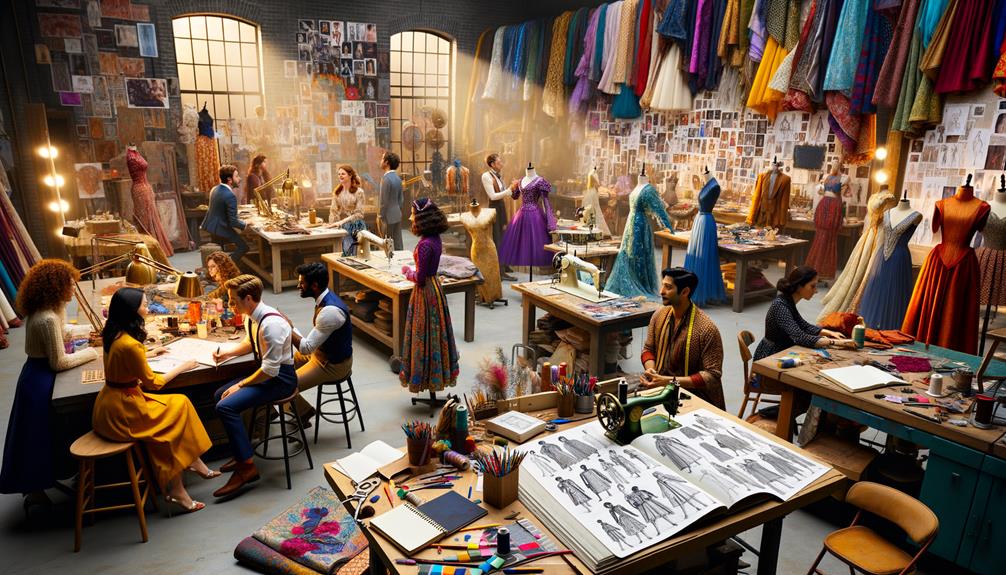
Collaborating with directors is a delicate dance, where every step aligns my creative vision with theirs to bring a unified aesthetic to life. As a costume designer, I find this synergy both challenging and rewarding. It’s a balance of merging my instincts with their narrative vision to craft characters that resonate on stage and screen.
In our initial meetings, I immerse myself in the director’s conceptual world, dissecting scripts, sharing visual references, and exchanging perspectives. These conversations are a crucible where ideas are refined and tested. The director’s insights shape my approach, guiding me to create costumes that enhance storytelling while staying true to the characters’ essence.
On set, I adapt constantly, responding to the director’s evolving vision. Sometimes it’s about subtle adjustments – altering a color palette or rethinking a silhouette. Other times, it’s more profound, like reimagining an entire look to better fit a scene’s emotional tone.
This intricate dance with directors pushes me to innovate, ensuring each costume not only complements the narrative but also adds depth. In this collaborative endeavor, we create a visually striking narrative that resonates with audiences.
Choosing Fabrics and Materials
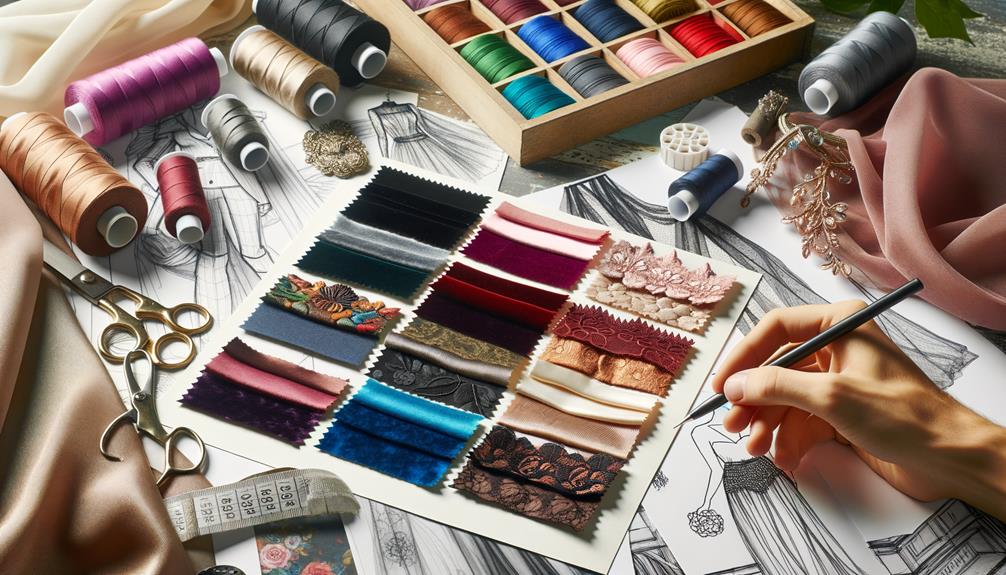
When selecting fabrics, I consider both durability and comfort alongside their visual appeal. It’s a delicate balance, ensuring the material not only withstands wear but also creates the desired aesthetic. These choices ultimately define the essence of the outfit and the story it tells.
Durability and Comfort
Durability and Comfort
Selecting the right fabrics and materials for costumes requires a delicate balance between durability and comfort, ensuring that each piece not only looks stunning but also feels great to wear. To achieve this balance, costume designers must consider several factors. For actors who will be under bright stage lights or performing physically demanding scenes, breathability and moisture-wicking properties are crucial. The weight and drape of the fabric also significantly contribute to the aesthetics and functionality of the costume.
Natural fibers like cotton, linen, and silk offer exceptional comfort and breathability, making them ideal for lengthy performances. They allow the skin to breathe and can wick away moisture. On the other hand, synthetic fibers like polyester and nylon provide superior durability, but may compromise comfort. When choosing these materials, designers must carefully weigh the benefits and drawbacks.
Some key factors to consider include:
- Breathability: Natural fibers help prevent overheating.
- Durability: Synthetic fibers stand up to repeated wear and tear.
- Care Requirements: Some fabrics require special maintenance, which can impact costs.
- Weight and Drape: Heavier fabrics suit structured designs, while lighter ones suit ethereal looks.
Ultimately, the choice of fabric can significantly impact the entire experience, both visually and physically, for the performers.
Visual Impact
In the delicate art of costume design, the fabrics and materials I select have a profound impact on the overall visual effect. As I choose the perfect textiles, I consider how the fabric’s weight, texture, and drape can transform a character’s silhouette. Heavy fabrics provide structure, while lighter ones create a fluid, ethereal quality. These decisions are crucial; they’re the foundation of the design.
Matte fabrics exude subtlety, whispering rather than shouting, while metallics demand attention, making a bold statement. Color and texture are also vital. A fabric’s hue must resonate with the character’s essence, and its texture must capture the audience’s eye, whether they’re seated in a theater or watching on a screen.
Authenticity often guides my choices. For a luxurious, high-society look, silk or velvet is unmatched. Conversely, rustic characters might wear cotton or linen, evoking a simpler, more grounded existence. It’s this blend of aesthetic consideration and historical accuracy that brings each costume to life.
Ultimately, every fabric and material I select serves a purpose, enriching the narrative and elevating the visual storytelling.
Creating Visual Impact
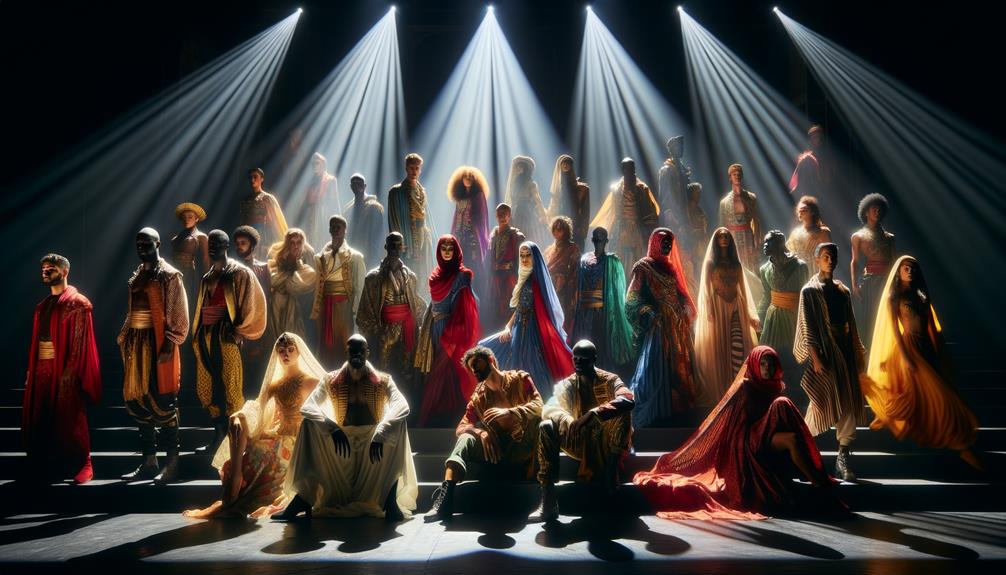
When I think about creating visual impact, I’m drawn to the way colors and contrast come together. The textures and layers of an outfit can evoke emotions and tell a story, kind of like a work of art. Each choice, each combination, is like adding a new element to a canvas of self-expression.
Color and Contrast
Creating a striking visual impact with outfits requires a thoughtful balance of color and contrast. In costume design for stage and screen, the interplay of colors can transform a character’s presence. A clear example is the iconic black and white costumes in ‘West Side Story’ (1961), where contrasting hues amplified the narrative tension.
To achieve harmony in an outfit, follow the 60-30-10 rule: 60% dominant color, 30% secondary color, and 10% accent color. This formula ensures that no single color overwhelms the costume, maintaining a visual balance. The 7-10% rule further refines this by limiting accent colors to small areas, enhancing without overwhelming.
Color temperature also plays a crucial role. Warm colors like orange and red evoke passion and energy, setting an emotional tone. Cool colors, on the other hand, can suggest calm or detachment, depending on the character’s needs. The use of analogous colors, as seen in ‘The Great Gatsby’ (2013), creates cohesion and harmony, enveloping the audience in a unified visual experience.
- Iconic contrasts: Black and white in ‘West Side Story’
- 60-30-10 rule: Balancing dominant, secondary, and accent colors
- Color temperature: Warmth and coolness to evoke emotions
- Analogous colors: Harmonious palettes like in ‘The Great Gatsby’
Texture and Layers
Exploring the intricate dance of texture and layers in outfit design reveals a rich tapestry of depth and dimension, transforming mere fabric into storytelling elements. When designing for stage and screen, I’m acutely aware of how texture can evoke emotion and layers can signify complexity. The way light interacts with different fabrics, or how a character’s vulnerability can be highlighted by a carefully placed sheer overlay, speaks volumes without saying a word.
Each layer I add isn’t just fabric; it’s a chapter in a visual narrative. Coarse, rugged textures might suggest resilience or hardship, while smooth, flowing materials could indicate grace or fragility. The audience, whether in a theater or watching a film, subconsciously interprets these cues, enhancing their connection to the character.
In the realm of stage and screen, texture and layers aren’t mere embellishments – they’re vital tools for creating visual impact. They provide a silent dialogue between the character and the audience, enriching the storytelling experience. By meticulously crafting these elements, I aim to push creative boundaries and inspire innovation, making each costume a crucial part of the narrative fabric.
Fitting and Adjustments
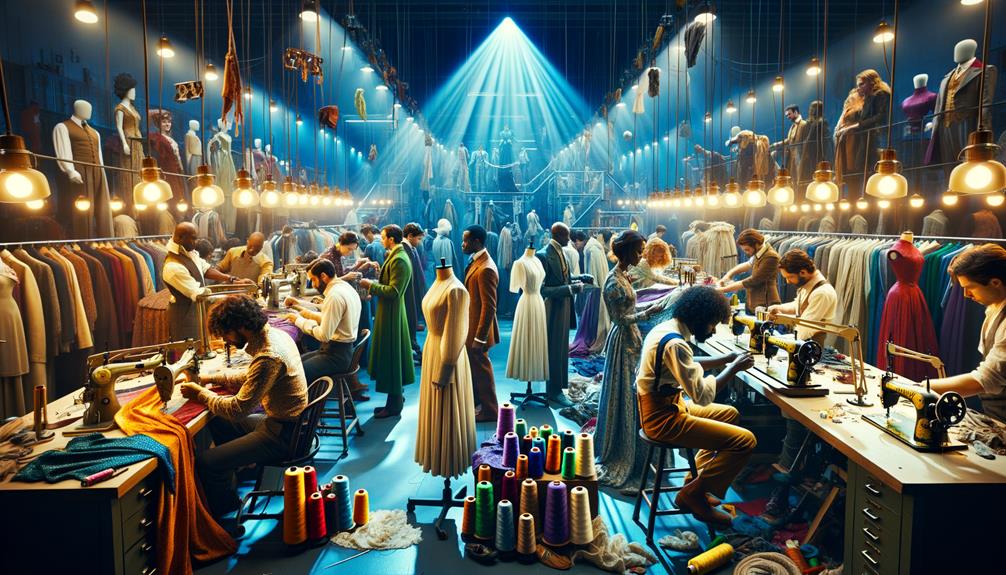
In the intricate process of designing costumes, fittings are a crucial step where the vision takes shape. Each session is a collaboration between the designer and performer, where precise measurements are taken and necessary adjustments are made. This process allows the costume to be tailored to the performer’s unique body, ensuring both comfort and functionality.
Modifications during fittings are vital refinements that bring the costume to life. Seams may need to be taken in or let out, hems may require shortening or lengthening, and sleeves or collars often need alteration. Each alteration brings the costume closer to perfection, enhancing the performer’s confidence and stage presence.
Multiple fittings are necessary to accommodate changes in the performer’s physique or design adjustments. The human body is dynamic, and repeated sessions ensure a flawless final product.
The benefits of this process include:
- Customized measurements for a precise fit
- Multiple fittings to accommodate changes
- Adjusting seams, hems, and collars
- Boosting confidence and stage presence
Through these fittings, the costume transforms from a concept to a second skin, embodying the character and captivating the audience.
Frequently Asked Questions
What Are the 4 Elements a Costume Designer Works With?
As a costume designer, I work with four core elements to bring a character to life. First, I consider the line of a garment, which defines its shape and silhouette. Next, I think about texture, which adds a tactile and visual depth to the costume. Then, I select colors that evoke the desired mood and atmosphere. Finally, I consider the mass of the garment, which gives it volume and a three-dimensional presence.
What Colors to Avoid on Stage?
When it comes to stage presence, I steer clear of white and black; these colors clash with the spotlight, creating harsh contrasts. Neon hues are overwhelming, drowning out subtlety. Gentle colors, on the other hand, blend harmoniously, drawing the audience into the narrative’s fold.
What Is the Best Color to Wear on Stage?
When thinking about what to wear on stage, I’m drawn to deep, rich hues. They add an air of mystery and grab attention, making it easy to incorporate creative lighting that enhances the performance.
What Key Aspects of Designing for the Stage Must a Costume Designer Know?
As a costume designer, I’m acutely aware that my craft requires a deep understanding of character, movement, lighting, and fabric. I strive to strike a balance between creativity and practicality, ensuring each costume not only enhances the narrative but also allows the actors to perform with ease.



